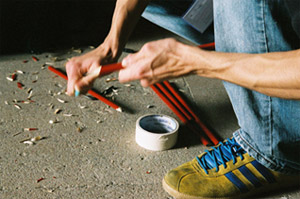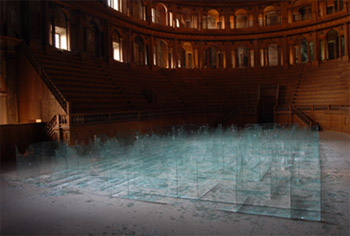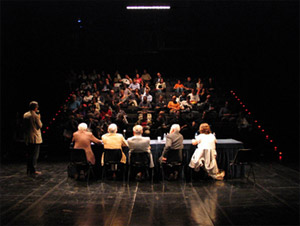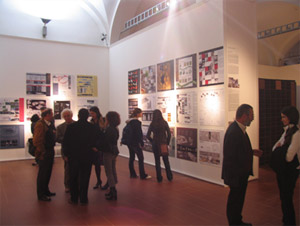|
HISTORY
Of the Festival dell'Architettura
The numbers of the Festival
FA1, ETEROARCHITETTURA, Parma, 20-26th september 2004
• 25 locations, 139 events, 200 partecipants, 5.000 visitors, 30.000 on-line vistors, 1 publication.
FA2, ARCHITETTURA ricchezza e povertà, Parma, 19-25th september 2005
•25 locations, 127 events, 250 partecipants, 6.500 visitors, 30.000 000 on-line vistors, 6 publications.
FA3, Architettura di rara bellezza, Parma, Reggio Emilia, Modena, 23-29th october 2006
• 3 cities for 14 locations, 79 events, 300 partecipants, 17.000 visitors, 52.000 000 on-line vistors, 3 publications.
 Parma Architecture Festival was born from a tradition of organisation and research which dates back to 1987 promoting activities of comparison, on an international level, between themes regading the architectonic and urban project. Parma Architecture Festival was born from a tradition of organisation and research which dates back to 1987 promoting activities of comparison, on an international level, between themes regading the architectonic and urban project.
A nearly ventennial experience which began with the seminars of “La Città del Teatro” (1987, 1990, 1994 – Edizioni CLUP e Abitare Segesta Milano), experiences projected to investigate the links between theater, dramaturgy and the city, until the next CITTAEMILIA. The 1998 Edition, Sperimentazioni architettoniche per un’idea di città, was dedicated to the system of places strategic for the development of Emilian cities, from Piacenza to Modena(Abitare Segesta Milano 2000), otherwise the 2000 edition , S.S.9, Via Emilia – Progetti architettonici e nuovi luoghi lungo la via Emilia tra città e città, tried to focus on the problems of the settling evolution along the historic axis of the consular road (Abitare Segesta Milano 2001), until the 2003 review, Architettura/Europa, taken inside the newborn Faculty of Architecture of Parma.
These events have brought together hundreds of professors, researchers, students from many of the italian and european architecture schools and universities; and have given back a solid network of contacts and references, interested in the approach at an architecture with solid links at an idea of city, context, culture. With the passing of time, after the specific occasion of the seminars, more opportunities of researching and experimenting with projects in the workshops have further nourished and consolidated this network of people, united by the interest in an architecture which is conscious of its urban role.
 Form this whole body of activities, human resources, experimental ways, even in the shape of an organised comparison and of the divulgation of its results, seemed to come out naturally the Festival model, as it was the more proper and fit to receive the evolution of a tradition rich of cultural activities, which are capable of a positive intervention in making the architectural debate wider and better known to a always bigger and more aware audience. The Festival is going, already at its fourth edition, towards a development of its abilities to research, narrate, investigate and spread the architectural phenomena with original and new techniques. Form this whole body of activities, human resources, experimental ways, even in the shape of an organised comparison and of the divulgation of its results, seemed to come out naturally the Festival model, as it was the more proper and fit to receive the evolution of a tradition rich of cultural activities, which are capable of a positive intervention in making the architectural debate wider and better known to a always bigger and more aware audience. The Festival is going, already at its fourth edition, towards a development of its abilities to research, narrate, investigate and spread the architectural phenomena with original and new techniques.
First of all, the setting: three different urban contexts (Parma, Reggio Emilia, Modena) for a metropolitan idea of Festival. To leave behind the dimension of oneness, of the cultural and enviromental microcosm, creating aerials which are near but far enough to pick up different waves.
The Festival bring always more life to a network made of talks, critical relationship between curators and involved subjects.
Something always add on to the construction of a community of the Festival.
The fourth edition opens with a great number of innovations: the Festival adopts a biennial form (07-08), inside of which is possible, given a general theme as a reference, to develop a deep and complex activity researching and producing the events, following a process which is always shown and given back during its various stages.
 The main fixtures for the 2007-2008 festival are: The main fixtures for the 2007-2008 festival are:
for the year 2007 (november and december) the seminars and lectures – to present the on-going status of the researches and to talk about the chosen themesi;
for the year 2008 (october and november) the exhibitions and the linked events.
The exhibitions and events will be opened, in all the spots, for at least four week; in every city of the festival four exhibitions are expected, with many events inside, each one of them placed inside one of five types:
- “container ” exhibitons, divided in many chapters and sections, referencig directly to the main theme of the festival.
- monographical exhibitions about architects, starting from what a particular architect could have given to the general theme
- photographic exhibitions, in which architect and photographs side by side work on the interested cities territories.
- general contributions to the main theme, even looking at other arts and forms of expressions.
- crash course in architecture.
The website of the Festival, moving on from the significant results reached during these years, follows the idea of giving back continuosly to the public the process inside the researches, and has reshaped itself as new centrepoint of the community of the Festival, and keeps inside its pages non-stop informations, updates, reflections, debates…
 Tit’s typical of the Festival to act researching a general theme towards thematic commonplaces, summarizing them to a different meaning, sometimes new, and however an object of reinterpretation. Tit’s typical of the Festival to act researching a general theme towards thematic commonplaces, summarizing them to a different meaning, sometimes new, and however an object of reinterpretation.
It seems now in great evidence the theme of landscape, which has a general and recurring attention. The landscape as identity, as an attractive factor, as a resource, memory, as… In this dimension of immanence of the landscape, and at the same time of contraddicitons and complexity operating inside it with projects, interpretating its conformation in its historical becoming, emerge the clear necessity to underline a link which we can call of responsibility: to be a common, public property, still in its determination towards private entities (other than public), from whom derives a collective responsibility upon its quality and its value.
From here came the title which describes the general theme of the festival: PUBBLICO PAESAGGIO (PUBLIC LANDSCAPE).
WebSite of FestivalArchitettura1
WebSite of FestivalArchitettura2
WebSite of FestivalArchitettura3
|